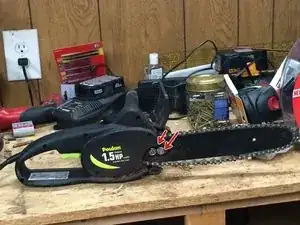
Chain Adjustment
These are some common tools used to work on this device. You might not need every tool for every procedure.
A chainsaw is an electric or gasoline-powered mechanical saw mainly used to cut wood. Chainsaws include a set of teeth attached to a chain that spins around a guide bar.
Possibly the first chainsaw-like tool was created by Bernhard Heine, a German orthopaedist, around 1830. This tool, called the osteotome, was used for cutting bone. It included a chain with small cutting teeth that rotated around a guiding blade by manually turning a handle. Through the 19th century, the chainsaw was mainly used as a surgical instrument. In 1905, Samuel J. Bens patented the first “endless chain saw” to fell the giant redwood trees in San Francisco, California. In 1918, the first portable chainsaw was patented by James Shand, a Canadian millwright. Andreas Stihl patented an electric chainsaw in 1926 and a gasoline-powered chainsaw in 1929.
Modern chainsaws include an engine, drive mechanism, guide bar, cutting chain, and tensioning mechanism. Chainsaw engines are generally two-strike gasoline internal combustion engines or electric motors powered by batteries or electric power cords. Chainsaw drive mechanisms are typically a centrifugal clutch and sprocket mechanism. Chainsaw guide bars are elongated bars made of alloy steel with a rounded end. The cutting chain is similar to bicycle chains but also includes cutting teeth that can vary in size and shape. Many chainsaws also include safety features including chain brakes, chain catchers, and rear handle guards.